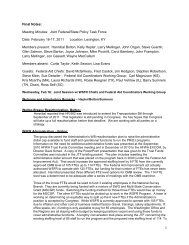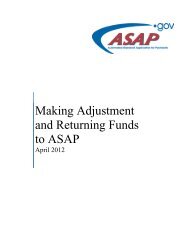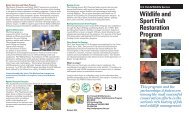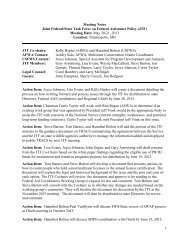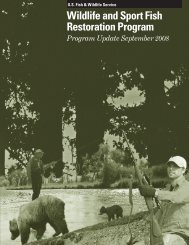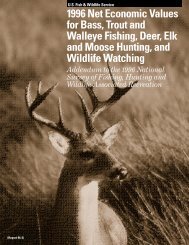Financial Returns To Industry From The Federal Aid - Wildlife and ...
Financial Returns To Industry From The Federal Aid - Wildlife and ...
Financial Returns To Industry From The Federal Aid - Wildlife and ...
You also want an ePaper? Increase the reach of your titles
YUMPU automatically turns print PDFs into web optimized ePapers that Google loves.
Case Studies<br />
Case studies of how local projects funded through the <strong>Wildlife</strong> Restoration Program<br />
benefit industry were identified using a two-pronged approach. <strong>The</strong> first round involved<br />
state self-nomination of projects. <strong>The</strong> second involved a review of U.S. Fish <strong>and</strong> <strong>Wildlife</strong><br />
Services‟ IFAIMS database. All projects were explored in depth to determine the level of<br />
data available to analyze return on investments. Those studies presented here are<br />
those which offered a rich level of data <strong>and</strong> should not be seen as an affirmation of any<br />
one particular project over another.<br />
<strong>The</strong> following section develops brief narratives fourteen case studies. Every effort is<br />
made to report either an Excise-Tax-Related ROI or <strong>To</strong>tal Project ROI or both in all case<br />
studies. However, not all case studies will present a ROI. Some will provide a synopsis<br />
of economic or other benefits to industry from specific hunting/shooting opportunities.<br />
As seen earlier in this report, the overall Return-On-Investment to industry related to the<br />
excise tax nationwide regularly exceeds 1,000 %. Individual projects funded with the<br />
excise tax can be viewed as individual holdings in an investment portfolio. While some<br />
holdings yield a positive return, others yield a negative return. Likewise, with wildlifeenhancement<br />
projects, most pay positive returns (as evidenced by the significant overall<br />
ROI) but others, when measured as a st<strong>and</strong>-alone entity, are negative. Those with<br />
negative financial returns are not inherently “bad investments.” <strong>The</strong>y may pay huge<br />
dividends to the advancement of knowledge to wildlife management <strong>and</strong> science that<br />
can be applied to make other projects a success – dividends that cannot be measured<br />
by traditional financial metrics. Additionally, a state relies on a mix of hunting<br />
opportunities to attract sportsmen <strong>and</strong> women to hunt in their state. Similar to grocery<br />
stores offering loss leaders in order to provide a wide selection of products that attract<br />
customers, a diversity of hunting/shooting opportunities in a state--some with positive<br />
ROIs to industry <strong>and</strong> some with negative--attracts more hunters. This is fine as long as<br />
the cumulative result of all projects is positive for industry.<br />
It is important to note that many of these case studies investigate projects that have<br />
spanned many decades <strong>and</strong> total program expenses are not attainable. In these cases,<br />
a period of “recent history” is highlighted to reflect annual rather than total investments,<br />
purchases <strong>and</strong> return on investments.<br />
Conservation <strong>and</strong> Management Case Studies<br />
Case #1: North Carolina Wild Turkey Re-introduction<br />
Data Contributors: North Carolina <strong>Wildlife</strong> Resources Commission, National<br />
Wild Turkey Federation.<br />
29




